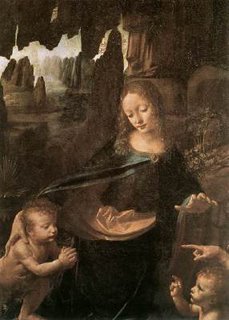
The Virgin of the Rocks
Brown and his main character, symbologist Robert Langdon, state that “the nuns” of the Confraternity of the Immaculate Conception gave Leonardo specific dimensions and themes about a commissioned painting for an altar triptych. But there were no nuns in the Confraternity; it was an all-male group, consisting of either brothers, or lay men, or a combination of both. More importantly, Brown states that “the nuns” had asked for a painting that would include Mary, Jesus, John the Baptist, and the angel Uriel, and he followed that request, but his first painting was filled with “explosive and disturbing details”.
Actually, Leonardo did not follow the Confraternity’s directives as to the subject matter of the painting. The original contract was to include a depiction of God the Father overhead, with two prophets on the side panels (The Virgin of the Rocks was the centerpiece). There has been much scholarly discussion about the exact nature of the contract and what exactly transpired between Leonardo and the Confraternity. What is clear is that Leonardo deviated substantially from the original plan for the subject matter—not that it contained “several disturbing ‘un-Christian’ anomalies”.
The Da Vinci Code correctly notes that there are two versions of this painting—the earlier one is in the Louvre in Paris and the later one is housed at the National Gallery in London. But Brown describes the painting as a “a five-foot-tall canvas”, when it is actually 198 x 123 centimeters, or about 6.5 feet tall (1.99 meters tall x 1.22 meters wide, according the Louvre web site). It was originally painted on wood panel, but was transferred to canvas; the second version of the painting, in London, is still on a wood panel.
In the novel, the main female character, Sophie, picks up the painting and moves it will relative ease; it is described as flexing as she pulls it from the wall. In reality, she likely wouldn’t have been able to move it or pick it up, and it’s doubtful that it would flex. Normally, such artistic license wouldn’t be much of a concern, but Brown insists his details are accurate, claims that he attended art school in Spain, and points out that his wife is an art historian. And yet he is completely wrong about the dimensions of a painting, even though the information can be obtained in a few minutes at the library or on the internet.
No comments:
Post a Comment